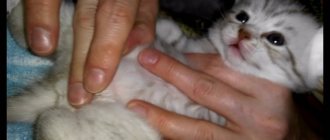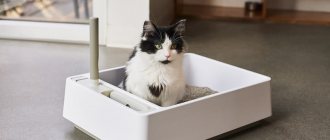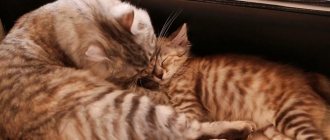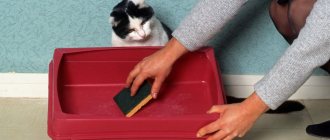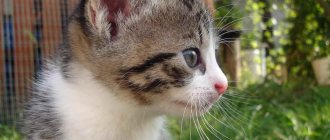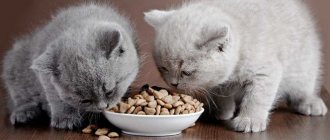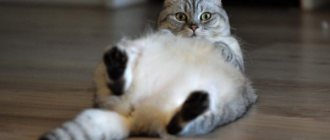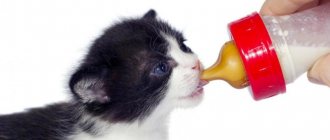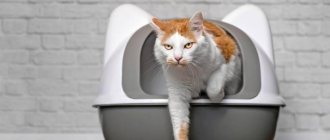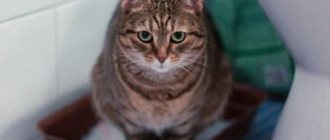26.05.2020
The mother cat closely monitors the toilet of a newborn kitten, carefully licking it and keeping it clean. With the arrival of a small kitten in the house, the responsibility for monitoring the proper functioning of its digestive system falls on the owner.
How often kittens go to the litter box determines their future health. To help the pet develop healthy, it is useful for the owner to know why bowel problems occur, how many times month-old kittens should go to the toilet, and what to do if the kitten does not go to the toilet for a long time.
Tray for newborn kittens
A mother cat helps a newborn kitten go to the toilet in the first three weeks of its life. A cat, licking its cubs, not only cleanses them of dirt and foreign odors, but also stimulates blood circulation in the digestive organs.
Thanks to this massage, it is easier for the kitten to get rid of gases and empty itself. The cat licks off all the dirt, leaving the appearance that the kitten does not go to the toilet at all.
"Attention! In order for the kitten to get into the tray without problems, it is important that the kitten tray has low sides.”
If for some reason the cat does not know how to provide proper care to the kitten, you can help him yourself. In a situation where the kitten does not want to go to bed for several days, and in order to eliminate the consequences of a bloated abdomen from gases, certain actions need to be taken.
Using a soft brush or cotton wool moistened with warm water, gently massage the kitten's belly in a clockwise direction in a circular motion. Additionally, a soft massage is performed in the direction from head to tail, with longitudinal movements.
Cat quirks
There is no more mysterious and enigmatic pet than a cat. Every cat owner can immediately tell you about a couple of quirks of his mustachioed pet. We have collected the most common cat oddities - and found explanations for them!
Why do cats love to chew and lick inedible objects?
Cats are partial to plastic bags, Christmas tree tinsel, rain, and other similar things. No wonder - objects made from these materials rustle very attractively, shimmer and attract cats in every possible way! How can you not chew such a wonderful thing? But here you need to be careful, and first of all, the owner! If a cat swallows a bag or rain, this is fraught with serious problems with its health, including death. Rain can cause intestinal obstruction or cut through the intestines. Pieces of polyethylene, once in the cat’s body, injure the mucous membrane - saving the animal after such a “lunch” is very difficult
As for the habit of cats to lick plastic and rubber objects, glossy magazines or photographs, there is nothing wrong with this addiction. It’s just that cats’ sense of smell is much more subtle than that of humans; they are attracted to unusual smells.
Why do cats “wrinkle” sheets and blankets?
Cats will not stop “working” with their claws even if the claws are removed - this is an instinct. And instinct tells the animal that to maintain good cat shape, claws need to be used regularly. Therefore, weaning a cat from sharpening its claws is a thankless task. If you value wallpaper and sofa upholstery so much, it’s better to remove the cat’s claws and let him imitate the “dot” to his heart’s content. As for the situation when cats settle down on the bed and begin to “wrinkle” the bedspread, this is normal. These actions are similar to the behavior of kittens suckling their mother cat. Adult cats do this when they experience the highest degree of comfort and satisfaction.
Why do cats sometimes “wash” people?
Cats can lick not only people, but also each other, dogs and other living creatures. But not any, but only the one that he loves very much! With the help of language, cats express their love and affection. So if your pet regularly gives you a “shame” session, do not drive him away from you - let him show his feelings!
Why do cats start running around like crazy after using the toilet?
They feel good - they went to the toilet, emptied their intestines, their soul felt better, their body also became more comfortable - why not be happy? And at the same time show the owner that he is in a great mood and nothing prevents him from starting the games!
Why do cats like to climb somewhere higher or hide in secluded places?
Instincts are again “to blame” for everything - they tell the domestic “predator” that it is more profitable to take a position somewhere higher, from where it is good to control the situation and it is easy to see both the potential victim and the possible danger.
Another instinct does not allow a single cat to pass by an empty shoebox, drawer or half-open closet - the mustachioed one will definitely climb into such a secluded place. Indeed, in nature, any cat predator always has a den where the cat can rest and gain strength. For example, a lynx's den is usually located in trees, while tigers arrange their resting places on the ground, in places hidden from prying eyes. Cats try to do the same thing at home!
Why do cats sleep so much?
Cats typically sleep up to 16 hours a day. Sleep is very important for a cat. If your cat doesn't get enough sleep, she will become irritable and aggressive and may even get sick. But only domestic cats sleep a lot - well-fed and well-groomed ones. A hungry animal that needs to find food for itself does not spend most of the day sleeping.
Why do cats eat house plants?
There are two reasons for this - firstly, perhaps they lack some vitamins and “eat” them out of indoor flowers. Secondly, domestic cats are often simply bored, and plucking plants brings pleasant variety to their, to be honest, not particularly eventful life. There is nothing wrong with this behavior of an animal if you don’t mind the flowers and the plants are not poisonous. Poisonous ones include: nightshade, spurge, ivy, cyclamen, azalea, poinsettia (Christmas star), etc.
Why do cats constantly rub their heads?
So they put their marks on everything that surrounds them. The fact is that cats have special glands on the sides of their heads, on their lips, which they use to mark their territory. They rub against the owner for the same reason - so that competitors know that this person is already “busy”.
Tray for one-month-old kittens
Upon reaching three weeks of age, the kitten’s intestines are already sufficiently populated with beneficial microflora, formed and ready to accept adult food. At this age, the kitten still feeds on mother’s milk with gradual complementary feeding in the form of liquid kitten food or creamy food. This food does not injure the intestines and does not require too thorough chewing.
At three weeks of age, a kitten should go to the toilet approximately 3 to 6 times daily. Normally, a kitten's feces should be mushy, uniform and thick. They should not contain impurities in the form of mucus or undigested food elements. The kitten itself should be cheerful, and its belly should be soft to the touch and painless. An unfavorable sign for the owner is kitten feces that are too dry or too runny.
If the kitten does not have stool for 3 or 4 days, you need to carefully analyze the pet’s diet. Abdominal massage, microenemas, and a small amount of vegetable oil can help.
Strong smell
Why does cat poop smell so strong? Everyone has heard about the extraordinary odor of cat feces, even those who are far from the animal world. There is only one explanation: purrs attach paramount importance to various odors. Your pussy leaves its scent marks everywhere. And when it rubs against its owner’s legs, and when it “butts” its head. Cats leave a unique smell everywhere, including on furniture and household items.
By the way, they are well aware of the specific aroma of their feces. Therefore, most cats try to bury (hide) them deeper and further away, so as not to attract the attention of large predators. However, there are also so-called “alpha”, or dominant cats. They display the products of their vital activity - they say, admire and smell. It’s a curious detail, but excrement contains a lot of useful and “educational” information. Japanese scientists say that whiskers “encrypt” even information about their own owners in feces. By the smell you can determine who left the “gift” - a cat or a female cat, what age it is, what food preferences are, what individual preferences are. However, you and I, no matter how hard we try, will not understand anything. Let’s just note one important thing: the smell has become too strong and intolerable - it’s better to show your pet to a veterinarian. Such a visit becomes a necessity when the animal suffers from chronic constipation or, conversely, incessant diarrhea. The final diagnosis of your pet will be made exclusively by a specialist.
Original publication: How Often Do Cats Poop? Author: Reyna Abraham. Source: cuteness.com Photo: pixabay.com
Toilet for adult kittens
The kitten is transferred to adult food from the age of 1 to 3 months. In general, coca feces become more shaped. The number of visits to the toilet, as well as the consistency of feces, depend on the type of food the kitten eats. When eating food with a lot of fiber, the number of bowel movements will be greater than with high-protein food.
A grown kitten goes to the toilet almost every day, and its feces should be free of blood, mucus, and undigested food. The owner should be wary of the fact that the pet often goes to the toilet with very liquid feces.
Diet for difficulty urinating
It doesn't matter what diagnosis the cat was given. If she has difficulty going to the toilet, this is a reason to reconsider her diet.
It is necessary to exclude cheap “economy” brands of food from her diet. They often irritate the mucous membranes, kidneys and urinary tract, causing additional pain in the cat’s body.
These foods contain a lot of salt, preservatives and dyes. The meat content there will be in last place, if it was used at all in the production of feed. It is recommended to switch the animal to expensive food of special brands designed specifically for animals with urological diseases.
It is strictly forbidden to give your cat:
- pork;
- salt;
- milk;
- raw meat;
- raw fish.
The diet must be agreed with your doctor
How often should a kitten pee?
When answering the question of how often a kitten should pee, you need to take into account the amount of liquid it consumes. The amount of urine should be equal to the volume of liquid drunk. A very small kitten has a small bladder capacity and will pee more frequently than an adult.
On average, a kitten goes to the toilet up to 10 times a day. An older kitten will have to go to the toilet up to 5 times a day. An adult cat goes small no more than 3-4 times a day.
"Attention! If your pet's diet is high in fiber, the number of trips to the toilet may increase."
The process of urination itself is normal and should not cause discomfort to the kitten. It is worth paying attention to the quality and color of urine, its transparency, the presence of impurities in the form of blood and mucus.
Why does a cat meow all the time at certain times of the year?
If their voice is associated with sexual needs, noted after reaching the age of six to nine months, the sounds made at such moments are difficult to confuse with anything. Loud, long-sounding “meows” do not give people who share shelter with the animal and those who are in the neighborhood any peace, regardless of the time of day. Owners who do not feel sorry for their own ears and nerves have the right to tolerate this, but it will be easier to match the pet with a suitable cat or think about castration.
Why does a kitten have problems with stool?
Stress has affected bowel function. A kitten may refuse to go to the toilet due to worries about moving to a new home, changing its owner, or being separated from its mother. To help the kitten get comfortable in a new place, you should protect it from noise, sudden movements, and games with children. The kitten itself must begin to play in the new territory, run, and go to the toilet. If the kitten does not defecate within 5 days, you should contact a veterinarian.
Due to poor nutrition, the functioning of the digestive system is disrupted. In a new home, the kitten must adhere to the diet of its old owners for some time, with a gradual addition of new cat food. When choosing ready-made food, you should pay attention to special diets for kittens.
If a kitten does not walk for more than 5 days, even having gotten used to a new place and food, then constipation may be the cause of problems with stool. By feeling your pet's abdomen, you can determine the presence of bloating, which usually accompanies constipation.
A sign of constipation is the painful process of defecation in your pet. Signs of constipation are also: sitting on the tray for a long time, plaintive meowing.
Treatment of abnormalities
Urolithiasis can be eliminated with the help of drug therapy and surgery. The veterinarian prescribes medications to improve the general condition and relieve intoxication. Typically, droppers with 5% glucose, 0.9% saline are used for this. solution, vitamins. To treat the disease itself, antibacterial and anti-inflammatory drugs are used, depending on the cause of the disease. Antispasmodics may be prescribed to relieve spasm of the urethra. For severe pain, painkillers and novocaine blockade are used.
If there are large stones that cause discomfort, severe pain and stagnation of urine, surgical intervention is performed. It is done under general anesthesia and is aimed at removing stones that will not pass out on their own due to their considerable size. After eliminating the disease, the veterinarian prescribes a special medicinal food for the cat, which it will eat for life.
How to deal with constipation in a kitten yourself
If your pet feels well enough, you can try to cope with your kitten’s constipation yourself with the help of:
- Oils: if the kitten does not go to the toilet for several days, you can give simple vegetable oil in an amount of no more than half a teaspoon per day. You can introduce it into the mouth using an ordinary syringe without a needle, slowly so that the kitten does not choke. Vaseline oil is also effective for constipation. It can be added at each feeding, 0.5 ml, in combination with a gentle therapeutic massage.
- Soap: you need to make a small peg of baby soap and insert it into the anus. Before administration, the soap should be moistened in warm water. It is more convenient to carry out this action while the pet is sleeping. After it, within a few hours, the kitten should successfully go to the toilet for the most part.
- Medications: You should consult your veterinarian about the appropriateness and correct use of medications.
- Enema: the enema procedure at home is carried out only in full confidence that it is harmless to the kitten. This procedure is relatively safe only if the cause of constipation is precisely inappropriate nutrition, and not intestinal obstruction or volvulus. There is a list of conditions for which an enema is strictly contraindicated: inflammatory processes in the intestines, bleeding, rectal prolapse, acute pathologies of the abdominal organs, inflammatory processes in the intestines.
Diabetes.
What is diabetes?
Diabetes mellitus is a disease in which a cat's body cannot effectively metabolize glucose and control its levels in the blood. Insulin produced by the pancreas is important for regulating carbohydrate metabolism. Insufficient insulin production is deadly.
There are two types of diabetes. And although it cannot be completely cured, you can ensure a happy life for a sick cat with proper nutrition, exercise and, if necessary, medications containing insulin. By using the right food and following the advice of your veterinarian, you can make your pet's life fulfilling.
What causes diabetes?
Injury to the pancreas usually leads to a reduction in insulin production. One of the tasks of this gland is to produce the necessary amount of insulin to regulate blood sugar levels. If it is damaged, deadly symptoms occur that must be eliminated immediately. In some animals, insulin may be less effective due to hormonal changes or medications.
Other factors that can increase your cat's risk of diabetes include:
Body condition. Overweight animals are more prone to diabetes. Obese pets are in the red risk group.
Age. Diabetes can be a problem in cats of all ages, but the highest incidence occurs in cats around 8 years of age.
Floor. Diabetes is more common in cats.
Breed. Burmese cats suffer from diabetes more often than others.
Other factors. Poor nutrition, hormonal disorders, stress.
Diabetes has the same symptoms as hyperthyroidism and chronic renal failure; there is a risk of making a mistake, which is why the disease must be diagnosed by a qualified specialist.
Signs of diabetes:
- Intense thirst.
- Fast weight loss.
- Refusal to eat.
- Fatigue, lack of energy.
- Vomit.
- Depressed state.
- Stomach ache.
- Frequent urination (quick tray filling).
IMPORTANT. If the diagnosis is confirmed, it is necessary to regularly visit a veterinarian for examinations.
He will do a blood sugar test and prescribe the necessary medications to keep your cat healthy.
Establish a strict regimen: this is the main factor in treatment. Feeding, training and, if necessary, taking medications - all this should happen every day at a strictly set time. This helps maintain constant blood sugar levels. Consult your veterinarian about this.
Although there is no cure for diabetes, veterinary experts say you can control diabetes with insulin, exercise and proper nutrition. Fiber plays a key role in disease management, as its consumption in moderate to large quantities reduces insulin requirements and blood sugar levels. Fiber also makes the body more responsive to insulin.
Do-it-yourself enema of a kitten
To do an enema yourself, you will need a 10-milligram syringe, warm boiled water, Vaseline or oil. It is advisable to do the procedure with an assistant: one will hold the kitten, and the second will slowly insert a syringe pre-lubricated (with Vaseline or oil), deep enough so that the liquid is distributed as intended.
During the procedure, you need to slowly introduce water, gently palpating the pet's stomach to ensure that the intestines are sufficiently full. For a kitten, 50-100 ml of water is enough for the procedure.
General information about the kitten's toilet
A kitten can go to the litter box from 10 times a day (in the early stages) to 5 times a day when growing up. If the kitten goes to the toilet too infrequently (up to 4 times a day), or goes to the toilet too often, or has other warning signs (blood, mucus in the urine), the owner should immediately contact a veterinarian.
On average, one-month-old kittens poop on their own 3 to 6 times a day. A kitten in a new place often does not go to the toilet for up to 5 days. If, after adaptation to the new place, the situation does not change, measures need to be taken.
The answer to the question of how often to change the tray depends on the composition of the litter. In general, after each visit to the litter box by a kitten, there should be no traces or smell left in it, otherwise the kitten will try to find another secluded place to relieve itself.
Urolithiasis disease.
Symptoms.
To independently detect at the initial stage and confidently make a diagnosis of “urolithiasis” without first examining the pet by a qualified specialist is a practically impossible task.
For pets at risk, regular clinical examination is recommended, during which changes in the composition of urine are recorded. Early detection of these changes will help to take preventive measures in advance.
Symptoms of urolithiasis:
- Urination is accompanied by pain.
- The cat goes to the litter box more than 5-6 times a day (it hurts to completely empty the bladder at once).
- Anxiety, aggression, other changes in behavior.
- Increase in abdominal volume.
- The appearance of blood in the tray or on the filler.
In the absence of proper treatment, the disease is accompanied by refusal to eat, sometimes vomiting or indigestion.
KSD is poorly treatable, and the results are not always stable.
Therefore, animals predisposed to the formation of stones in the urinary tract should be given increased attention. Prevention of urolithiasis in cats includes:
- Regular examinations by a veterinarian (tests according to the doctor’s indications for early diagnosis of pathology).
- Once every 6-12 months - ultrasound of the genitourinary system.
- Adjusting the diet to minimize calcium salts and other compounds that can stimulate the formation of uralites. So, the basis of the diet should be lean meat with the addition of vegetables, but fish, eggs, cottage cheese and other dairy products should be excluded.
Prevention of urolithiasis in sterilized cats follows the same scheme, but the symptoms must be treated more carefully. Sterilization itself has little effect on the likelihood of developing pathology, but often it is the operation that becomes the stress that disrupts metabolic processes.
To prevent the development of kidney and bladder diseases, you need to use high-quality food and not neglect regular examinations by a veterinarian.
With prolonged patience, urine concentrate poisons the body, so at the first signs of illness, immediately show your pet to a veterinarian.
